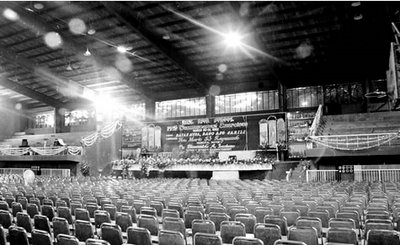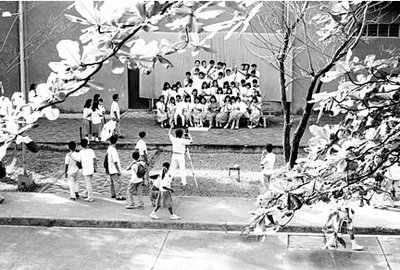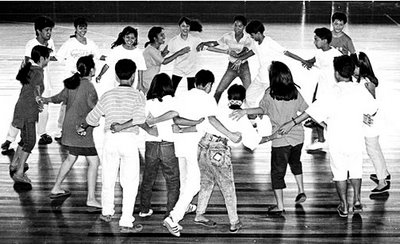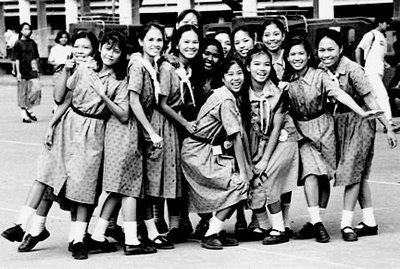| “Photographers are timekeepers” |
Photojournalism has been a part of the division, regional, and national press conferences since 1989, and as a result, schools are finding ways to train their staffers in the field of photography. If you’re a school paper adviser, staffer, or a student taking up a course with a curriculum that requires photography like Mass Communications, Fine Arts, Interior Design, or you’re interested in photography as a hobby, this series is definitely for you.
 I fell in love with photography when I fell in love with Hollywood actress Candice Bergen way back in my high school days in the 1970s.
I fell in love with photography when I fell in love with Hollywood actress Candice Bergen way back in my high school days in the 1970s.You might know Candice Bergen as the star of the TV situation comedy “Murphy Brown,” but to my generation, we knew her as the lead star in the hit movie “Soldier Blue” (1970). She played the role of “Cresta Lee,” a strong-willed and resourceful woman who as a child, was raised by Apache Indians after her family was massacred. After being assimilated into the Indian culture, she planned to return to her American relatives in New York (if memory serves me right). But fate intervened, and the payroll convoy she was in was attacked by another group of Indians on the warpath.
Caution: “Soldier Blue” is an R-rated movie. |
 |
| Caution: “Soldier Blue” is an R-rated movie. |
College days
 I spent part of my college days in Philippine Christian University, where I graduated with an AB English degree in 1979. That teenage crush I had on Candice Bergen developed (no pun intended) my love for photography; the problem was, I didn’t have an SLR camera. One PCU student at that time was the unofficial school photographer, covering various programs, shooting candids of students and professors, etc. Every time I’d see him along the corridors, in the library, with his camera slung on his shoulder, I would wish that I also had my own camera.
I spent part of my college days in Philippine Christian University, where I graduated with an AB English degree in 1979. That teenage crush I had on Candice Bergen developed (no pun intended) my love for photography; the problem was, I didn’t have an SLR camera. One PCU student at that time was the unofficial school photographer, covering various programs, shooting candids of students and professors, etc. Every time I’d see him along the corridors, in the library, with his camera slung on his shoulder, I would wish that I also had my own camera.Since I couldn’t afford to buy a camera, I became content with looking over and over again at Time and Newsweek magazines that carried a lot of advertisements for SLR cameras. I couldn’t understand then a lot of the technical terms and descriptions about cameras. I didn’t know, for example, the difference between a “35 mm camera” and a “camera with a 35 mm lens.” I just loved looking at pictures of Canon, Nikon, Minolta, Olympus, and Pentax cameras, wishing all the time that I had my own single lens reflex camera. (One camera model that really caught my attention was the Pentax K Spotmatic.)
I also began to love looking at things, situations, and people, imagining myself taking pictures. One time, I saw an old woman who was rolling two huge truck tires all by herself up a street across the public market in Mandaluyong. I told myself, “Hey, this would make a good picture!” Another time, I came across about a dozen CEU nursing students who were waiting to cross the street, looking prim and proper in their white, neatly-pressed uniforms with pink gowns. I thought that if I took their picture, I’d caption it, “In the Pink of Health.”
Going to PCU in the morning and coming home in the afternoon, I would always pass by P. Guevarra street in San Juan where I loved looking at the big, old houses. One two-storey house, rather worn out at the time, intrigued me so much. It must have been a gallery because it had a lot of paintings that were hanging on the walls (it’s now a fancy restaurant). Near the stone steps that led to the 2nd floor was a garden of sorts. I was reading Nathaniel Hawthorne’s stories at the time, and my lively imagination told me that this garden, especially in the rain, looked like the secret garden in his story “Rappaccini’s Daughter.”
What really attracted my attention to this house were the numerous statues of Jose Rizal in various poses, strewn about the garden. Everyday, when I passed by that house, I’d wish that I had a camera so that I could shoot those statues and that house. I already had a caption in mind: “We Need More of Him.” Sometimes I’d have the urge to open that gate, talk to whoever the owner might be and ask permission to haul the statues to our house in a nearby street.
The house on the hill
We lived in an old, two-storey wooden house perched on top of a hill, blessed with a sweeping view stretching from the faraway skyline of Makati to the buildings on Roxas Boulevard in Manila. In the afternoons when I had no classes and after I had fed the pigs in our backyard, I would lie down on a window ledge and stare at that great view for hours.
There was a santol tree in our front yard, and in the afternoons after I had helped my mother bring the refreshments that she sold in a nearby elementary school, I would climb the tree and watch the sun setting down behind a mountain across Manila Bay. One time, as I watched the late afternoon sun bathing that mountain in golden sunlight, it suddenly occurred to me that mountain must be the one shaped like a sleeping woman that National Artist for Literature Nick Joaquin described in his story, “The Woman Who Had Two Navels.”
We don’t live in that house anymore, and one of the great regrets in my life is that I didn’t have a camera then to take a picture of that mountain.
Photography and philosophy
Thomas, the lead character (played by David Hemmings), takes pictures in Maryon Park. After printing his pictures in the darkroom, he begins thinking that he has taken a picture of a murder in the park. The famous ending of the movie where Thomas watches two mime artists playing tennis. Note: “Blow Up” has explicit scenes that are not suitable for young audiences. |
The photographer begins investigating whether the murder actually took place, blowing up his pictures more and more. The pictures seem to tell him that indeed he had recorded a murder, but his investigation leads him towards a blank wall. At the end of the movie, the photographer goes back to the park one early morning, and he comes upon two mime artists playing tennis without rackets, without a ball, without a sound. As these mime artists began playing, serving and lobbing an imaginary ball over an imaginary net, the movie ends as a flash of recognition, of deeper understanding crosses the photographer’s face.
What attracted my attention most about this movie were the scenes showing the photographer in the darkroom. It was only after I’ve read Francis Schaeffer’s book “A Death in the City” did I come to fully realize what director Antonioni was trying to say through his movie. Philosophically, through the photographer’s failure to come up with empirical evidence of the murder which he thought he had captured on film and through that imaginary game of tennis one early morning in the park, Antonioni was saying that there was no absolute moral standard in the universe, that everything was relative. (See also “Modernism and Post-Modernism | An Analysis of Blow-Up.”)
 Photography and philosophy ... what did Candice Bergen do to me! In l983 the film “Gandhi” starring Ben Kingsley and directed by Sir Richard Attenborough won as the Oscar Best Picture of the Year. A minor character in the movie based on the life of Mahatma Gandhi is that of Margaret Bourke White, a world-famous photographer for Life Magazine and the first woman to be accredited as war photographer during World War II. Guess who played that role? Who else but Candice Bergen!
Photography and philosophy ... what did Candice Bergen do to me! In l983 the film “Gandhi” starring Ben Kingsley and directed by Sir Richard Attenborough won as the Oscar Best Picture of the Year. A minor character in the movie based on the life of Mahatma Gandhi is that of Margaret Bourke White, a world-famous photographer for Life Magazine and the first woman to be accredited as war photographer during World War II. Guess who played that role? Who else but Candice Bergen!Rizal High School; learning by doing
 Sometime in 1985, I bought my first and only SLR camera, a Canon AE-1 Program camera. Finally, I had a camera! At that time, I had just left Quezon City Science High School as journalism teacher and school paper adviser and had transferred to Rizal High School, where I worked until 1995. (From 1993 up to 2005, Rizal High School was recognized by the Guinness Book of World Records as the world’s biggest high school, with enrollment reaching 26,000 students at one point.)
Sometime in 1985, I bought my first and only SLR camera, a Canon AE-1 Program camera. Finally, I had a camera! At that time, I had just left Quezon City Science High School as journalism teacher and school paper adviser and had transferred to Rizal High School, where I worked until 1995. (From 1993 up to 2005, Rizal High School was recognized by the Guinness Book of World Records as the world’s biggest high school, with enrollment reaching 26,000 students at one point.) |
| My beloved Canon AE-I Program camera with Vivitar 28-210 mm zoom lens. |
During that time, I took more than 10,000 pictures (mostly black-and-white) with my beloved Canon AE-1 Program camera, Canon FD 50 mm lens, and Vivitar zoom lenses (a 70-210 mm Series 1 and a 28-210 super zoom). I also used with my lenses either a green filter or a polarizing filter.
I started with films such as Negrapan (made in Barcelona, Spain) and the locally-packaged Colpan. I also tried Ilford HP 5, but later on, I primarily used Kodak Tri-X Pan because it was used exclusively by my idol, Sebastiao Salgado, the world’s best photojournalist.
I learned about photography through trial and error, by asking for help from other photographers, and by reading books and magazines. Every time I had the money, I would go to all the sidewalk stalls in Avenida Rizal to buy photography magazines. I would start from Recto, opposite Odeon Theater, and then transfer from one side to another of Avenida Rizal until I reached Plaza Sta. Cruz.
 |
| My RHS Class '92 students (Leili, Stevenson, and Daniel) in our makeshift darkroom |
I enrolled in a 15-Saturday workshop in black and white photography. I was only able to attend about four classes, but I learned enough to start processing films and printing pictures on my own.
Together with my students, I processed the black-and-white films and printed the pictures in our school’s makeshift darkroom. I used the cheap, locally-manufactured Atlas developer and fixer; for the photo paper, I primarily used Grade 3 Oriental or Agfa Portriga.
I watched photo exhibits, and I learned by asking myself what made these pictures good enough to be exhibited. I integrated photography into my journalism classes to make them more interesting to the students; seeing several of my students begin to take photography seriously inspired me to learn more.
From photojournalism book to photojournalism blog
Based on some of the pictures that I took, I wrote a book on photojournalism way back in 1997. For the next two to three years, I went to numerous book publishers trying to get my book published, but to no avail. The book publishers told me that there was no market for the book.
In 2001 or 2002, a company called Pyra Labs created the “weblog,” a new platform for writing on the Internet. Pyra Labs was later on bought out by Google, which then transformed the “weblog” into the Blogger platform.
After studying basic HTML, I started this blog and several others in 2005. I rewrote the chapters of my photojournalism book so that they would fit the blog post format. I wrote 40 lessons on photojournalism for this blog; you can find the links to these lessons in the sidebar.
Since then, I have been editing these lessons to keep them up to date with developments in digital photography. I have also embedded relevant YouTube videos in some posts. (But the techniques of photographic composition are the same whether you're into film-based photography or digital photography.)
Photojournalism and the various school press conferences
 Photojournalism has been a part of the division, regional and national press conferences since 1989. Last year, I was the lecturer and contest judge in photojournalism for the following seminars or press conferences:
Photojournalism has been a part of the division, regional and national press conferences since 1989. Last year, I was the lecturer and contest judge in photojournalism for the following seminars or press conferences:1. Photojournalism seminar, Maria Montessori Christian School, Pembo, Makati, August 19, 2006
2. Photojournalism training and contest, District 5, Division of Pasig City and San Juan, Caniogan Elementary School, September 7 and 8, 2006
3. Photojournalism contest and Division Press Conference (grade school level), Division of Pasig City and San Juan, October 5 and 10, 2006
4. Photojournalism seminar, Santolan High School, October 20, 2006
5. Photojournalism lecture and contest (high school level) Division of Pasig City and San Juan, November 7, 2006
6. Regional Schools Press Conference, Region III, Talavera, Nueva Ecija, November 14-17, 2006
Schools are trying to find ways to train their staffers in the field of photography. A lot of schools and students are hampered, however, by the high cost of photography books and the lack of training workshops. What’s worse, some schools do not even have cameras; they rely on their students to provide the cameras.
| Be a better writer or editor through StyleWriter 4: this software checks 10,000 words in 12 seconds for hundreds of style and English usage issues like wordy and complex sentences, passive voice, nominalization, jargon, clichés, readability, spelling, etc. StyleWriter 4 graphs your style and sentence variety, and identifies your writing habits to give an instant view of your writing. You can learn to adjust your writing style to suit your audience and task. You can learn, for example, the writing style of Newsweek, Time, The Economist, and Scientific American. StyleWriter 4 is widely used in the US federal government (for example, the Environmental Protection Agency). It can be used by educators, students, and professionals in various fields - business, law, social or physical science, medicine, nursing, engineering, public relations, human resources, journalism, accounting, etc. Download your free 14-day trial copy now. |
If you’re a school paper adviser, staffer, or a student taking up a course with a curriculum that requires photography like Mass Communications, Fine Arts, Interior Design, etc, or you’re interested in photography as a hobby, this series of postings is definitely for you. It’s my hope you’d be inspired to learn more on your own about photography.
I’ve, however. used the term “photojournalism” in a rather loose but restricted way in this series. Loose because photojournalism is the application of photography to a class of events that people classify as “news.” Most of the topics we will discuss, however, are the basics, the foundations of photography. It’s restricted in the sense that I have limited the term to “campus news photography.”
Photography is a hard taskmaster
Like any other art, skill, or talent, however, photography is a hard taskmaster. If I may borrow the words of the late writer Maria Luna Lopez, photography, like journalism, is a jealous and demanding mistress. To learn photography, you should invest time and effort in it.
One other specific area I wish I could really contribute is in disabusing the minds of some advisers and editors who believe that articles are always better than photographs. These advisers and editors (who are in the very small minority, thankfully) love to fill their publications with columns upon columns of text, with almost no pictures at all. As a result, their publications have a lot of “gray pages.” The modern trend in publications worldwide is the use of bigger and bolder graphics (pictures, drawings, headlines, etc.), without sacrificing of course, substance and depth in the articles. This trend is influenced by the impact of television, computers, and other forms of electronic communication on our everyday lives.
Marshall Macluhan, world-famous author of the book “The Medium is the Message” once said that electronic media has brought about a new form of illiteracy. A lot of people today are visually literate and sophisticated but have lost the ability, the skill, or the patience to read full-length articles or books.
I am not advocating of course, this “New Illiteracy” as Macluhan described it. What I wish to emphasize is a philosophy in journalism known as “editing by design.” Simply put, this philosophy stresses that contents and design must always go hand in hand. Advisers and editors must work together with photographers, art directors, and layout artists. Any publication, whether a school paper or a yearbook, must not only “read well” but also look good.
The power of photography
World literature tells us the tragic story of Faust who vowed to bargain away his soul if he could find one perfect moment of happiness. He would eternally forfeit his soul if upon finding that one perfect moment of happiness, he would say the words, “Stay, you are so beautiful.” He couldn’t find that happiness in his relationships, in society, in achievements, but he did find it in a small village by the sea, with the sun setting down and mothers calling upon their small children to come back to their homes. In the simple joys of these village folks, Faust found his one perfect moment of happiness. At last, he said the words, “Stay, you are so beautiful!” and his soul was eternally forfeited.
 Photography has the power to capture not only our perfect moments of love and happiness but also searing images of cruelty and poverty. It has the power to preserve in a rectangular frame the beauty of a thousand sunsets, the joys of parents seeing their child just learning how to walk on its own, and the sublime happiness of students graduating after years of hard work and sacrifice.
Photography has the power to capture not only our perfect moments of love and happiness but also searing images of cruelty and poverty. It has the power to preserve in a rectangular frame the beauty of a thousand sunsets, the joys of parents seeing their child just learning how to walk on its own, and the sublime happiness of students graduating after years of hard work and sacrifice.Unlike Faust, however, we do not have to bargain away our souls in order to capture our perfect moments of happiness. We only have to pick up our cameras, look at the world through the view-finder, and, as life passes before our lenses, capture these perfect moments of happiness on film, as we say in our hearts and minds, “Stay, you are so beautiful!”
Nat Geo videos on power of photography to witness, to reveal, to relate, to prove, and to celebrate
| Update as of September 18, 2023:
If you’re a high school or grade school student in the Philippines who’s joining the photojournalism contest in the division, regional, or national press conference, I’m offering two free resources to you : A. 900-plus interactive exercises on English grammar, vocabulary, reading comprehension, verbal analogy, etc (with around 200 megabytes total file size). The exercises have time limit and automatic scoring, with an average of 10 items per exercise. Examples of these interactive exercises are: Common English grammar errors: Exercise 01 (nouns - confusions of number); Phrasal Verbs: Expressions with Go; English Placement Test (45 items). B. 200-plus resources (JPG, PDF, MP4, etc.) on photography and photojournalism, with 600-plus megabytes total file size. For some examples of these resources, surf to the “Free photography e-books, cheat sheets” page. For the download links and more information about how to use the interactive exercises, please surf to my “Better English resources and exercises” blog. Please inform your journalism teacher/schoolpaper adviser or your parents about these resources before downloading them. If you have any question about downloading or using these free resources, please email me (after informing your journalism teacher/schoolpaper adviser or your parents). I’ll be able to reply to you within two to three days; if you don’t see my reply in your Inbox, check your Spam folder. Or, you can text me. Also, if you win in the photojournalism contest at whatever level (district, division, regional, or national), you can send me your prizewinning pictures, and I will feature them in a blog post. Atty. Gerry T. Galacio gtgalacio@yahoo.com 0927-798-3138 |






1 comment:
hey sir,
I bumped into your site while i was googling about photojournalism.
We have a lot of things in common pala.
I also have my canon ae1 program. (I'm using it for the photojournalism contest, nice old camera). I'm still learning though.
I will be reading your posts about it. Thank you in advance.
Post a Comment